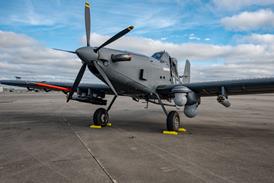Guy Norris/LOS ANGELES
BOEING IS CONTINUING studies of 747 stretch designs, despite the suspension of joint studies with the Airbus partners of a very large commercial transport (VLCT) on the basis of insufficient market potential. The company is concentrating on two design options - the largest able to carry up to 800 people.
The two-and-a-half-year joint study was frozen at a meeting in Long Island, New York, on 7 July. Boeing says that the study "...is not completely over and done with, and another meeting is planned for sometime in 1996 to review the marketplace". It adds that "...the decision over the VLCT doesn't change the status of the New Large Airplane [NLA] studies, which will continue".
The VLCT study, with Aerospatiale, British Aerospace, CASA and Daimler-Benz Aerospace (DASA), had identified a potential initial market of up to 1,000 aircraft by 2020 (Flight International, 4-10 January). Since these early findings, however, the continued trend towards "fragmentation" of long-range markets by twin and tri-jets led to fears that this figure may be substantially over-optimistic. The next phase of the VLCT study would have entailed evaluation of a common configuration and the establishment of a joint-venture company.
Most of the airlines within Boeing's informal NLA advisory group are now believed to be pushing the manufacturer towards two main 747 derivatives, rather than an all-new design. All the group members are 747 users and represent more than half of the 20 carriers identified by Boeing as the main target market for the NLA.
British Airways believes that a stretch for the 747-400 is "inevitable", says chairman Sir Colin Marshall, who says that it could be in service by 1999.
Although he admits that Boeing has given no official launch to the new aircraft, Marshall says that BA is anticipating the availability of an aircraft with a three-class capacity of up to 523 seats. He adds that BA still believes that a new high-capacity aircraft is also likely to be launched.
The launch of the stretched aircraft is crucial to BA's plans to expand at London's slot-constrained Heathrow Airport. Over the next 15 years, the aim is to raise passenger numbers through the airport by more than 50%, to around 36 million, while increasing the fleet by only 12 aircraft.
The two designs, dubbed the 747-500X and -600X, would have new wings and fuselage cross-sections, offering cockpit commonality with the 747-400. There could be a market for up to 500 aircraft by 2010.
The 747-500X would be a modest 6m stretch of the -400, offering seating for around 530 in a tri-class arrangement, with a range potential of more than 12,950km (7,000nm). The 747-600X would be up to 18m longer than the -400, with a wingspan of around 79m - the largest span possible for an aircraft using 747 gates without a folding wing. The -600X would seat more than 600 in a tri-class configuration, but up to 800 in a high-density arrangement.
Boeing comments officially that it "...is examining 747 derivatives that would provide greater range, performance and economic value. Current 747 studies are focusing on wing and fuselage modifications necessary to satisfy future air-travel growth demands."
The European companies have little to say officially about the cessation of the study, but the decision to suspend the talks leaves them with a dilemma. Most seem pessimistic about the likelihood of a resumption of negotiations in six months' time, given that Airbus' own studies into its A3XX, which would be smaller than the VLCT, appear to be gathering some momentum.
There are, however, differences between the partners on the priority for investment. Aerospatiale's president, Louis Gallois, has repeatedly made the case for increased research into a supersonic transport to support what the company believes is a potential market for 500 aircraft by the year 2025. DASA, the other main Airbus partner, is thought to favour an A3XX-type solution.
Source: Flight International























